The History of the Soho District of Pittsburgh
Survey of Workingmen’s Homes in the Soho District of Pittsburgh
A Study of Civic Neglect in the Heart of a Great City
by Abraham Oseroff, M. A. [1914]
The original article is available HERE.
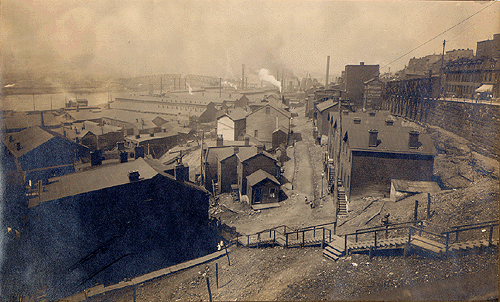
Within five minutes street-car ride of that imposing monument of Architect Henry Hobson Richardson’s skill and artistry–the Allegheny County Court House; within ten minutes walk of the beautiful Schenley Farms District, in the other direction, where are grouped some of Pittsburgh’s finest and richest homes; within view of the University of Pittsburgh and the Carnegie Institute of Technology; and as a next-door neighbor to the several rich and influential churches, lies an example of housing conditions which, in its absolute disregard of the most urgent and essential sanitary requisites for human habitation, is thoroughly revolting to every sense of civic decency.
The district affording this study covers an area of twenty-two and nine-tenths acres and has as its boundaries the twenty-Second Street Bridge, Forbes St., Lawn Street, and the Baltimore and Ohio Rail-Road tracks, running adjacent to Second Ave. It comprises one hundred and twenty-six families living in sixty-five houses, which lie within the shadow of the huge furnace of the Jones and Laughlin Steel Mills, of the extensive plant of the National Tube Company, and of Hussey and Company’s Copper Works.
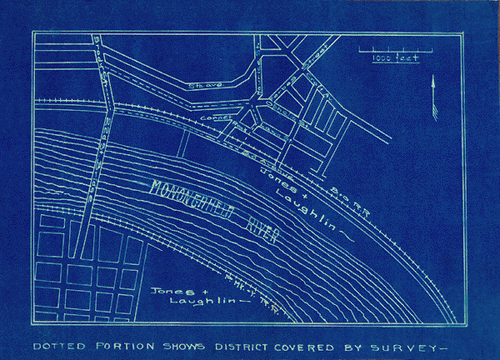
On Forbes Street following the numbering of the houses there are four blocks from 2300 to 2600. The beginnings and the ends of the blocks, however, are arbitrary since there are no streets running South from Forbes Street between the Twenty-Second Street Bridge and Lawn Street. From Forbes Street the entire district grades down toward Second Avenue, forming in its descent Rock Alley, Rock Street, Maurice Street and Cornet Street.
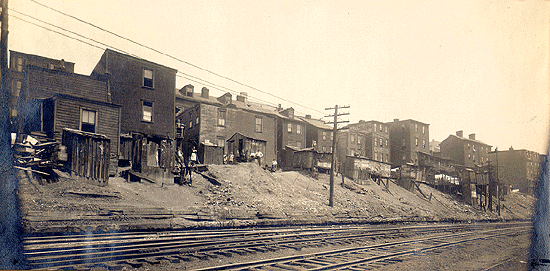
A dismal, unkept, uncared for rut running into the hillside, immediately below the Lawn Street Bridge bears the designation of Rock Alley. It is lined on both sides by a variety of houses built at an almost equal variety of angles. One house here takes care of five families and a tiny attic room did its best one cold March morning to provide air space for six sleeping millworkers with the two windows and the only door tightly closed. 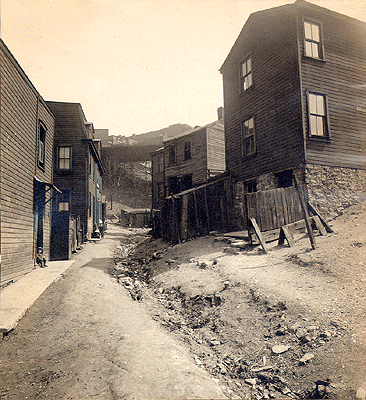 Another house has as an appendage a little frame shack which does service as a kitchen. On this same March morning, with the thermometer hovering about the freezing point any visitor could have seen a family group eagerly crowding about a little stove in one corner of the room. John, the oldest of the children, spoke up and said: “Gee, mister, the stove is the only warm spot in this house.” And he was right for the wind and the snow found no difficulty in crossing the fragile barriers of doors and windows and took full advantage of the many crevices between decayed boards.
Another house has as an appendage a little frame shack which does service as a kitchen. On this same March morning, with the thermometer hovering about the freezing point any visitor could have seen a family group eagerly crowding about a little stove in one corner of the room. John, the oldest of the children, spoke up and said: “Gee, mister, the stove is the only warm spot in this house.” And he was right for the wind and the snow found no difficulty in crossing the fragile barriers of doors and windows and took full advantage of the many crevices between decayed boards.
The population of Rock Alley is even more diverse than are its houses. Unassorted there are living, side by side, a mixture of American, Welsh, Irish, Hungarian and Polish families, and, indeed, a German boarder in the crowd.
Rock Alley, in spite of its many other afflictions, was not destined to escape the privy vault nuisance. It has its share of unsanitary, disease-breeding vaults without sewer connection, ever ready to spread contamination and endanger the health of the neighborhood.
Rock Street makes itself particularly conspicuous through its long, open, wooden sewer drain carrying sewerage from both the alley and the street toward Maurice Street. Its sluggish way is hardly ever unimpeded for Rock Street residents do not find themselves well versed in the best standards of sanitation. And so the sewer drain becomes the resting place of an innumerable number of empty tin cans, worn-out brooms, old shoes, and other articles equally as foreign to the lap of the respectable sewer. As a result during rain or when the sewer is otherwise forced to its capacity these same residents complain of great discomfort because of the inevitable overflow into their cellars and basement kitchens.
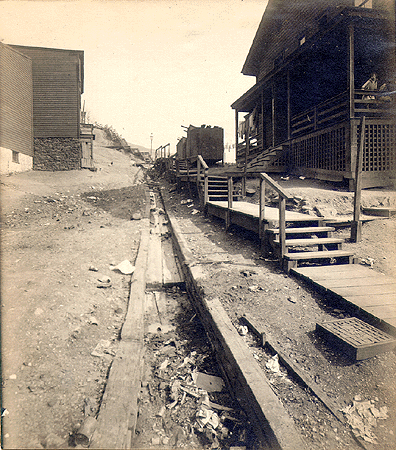 The tenement shown in the foreground of the picture of Rock Street, boasts of a population of five families but it redeems itself in part at least, for it is one of the very few houses in the district affording inside water closet accommodations. Its neighbor on the other side of the street is less fortunate in this respect and two families must depend for toilet accommodations on a dry privy vault placed under a side porch adjacent to the kitchen.
The tenement shown in the foreground of the picture of Rock Street, boasts of a population of five families but it redeems itself in part at least, for it is one of the very few houses in the district affording inside water closet accommodations. Its neighbor on the other side of the street is less fortunate in this respect and two families must depend for toilet accommodations on a dry privy vault placed under a side porch adjacent to the kitchen.
Maurice Street, one of the main thoroughfares of the district, forms a direct connecting link between Forbes Street and Second Avenue. Here for the first time we encounter a tenement court. It consists of two dilapidated frame shacks at the rear, each of which accommodates two families; a brick hovel in the front occupied by one family; and a brick house providing living quarters for four families. For these nine families and boarders the sole water supply is one hydrant adjacent to a privy vault.
On Cornet Street there are houses in the last stage of dilapidation but still occupied and still a source of income to the landlord. Basement rooms are plentiful and foul, unsanitary privy vaults are open to the sight of all passersby.
The worst housing conditions of the district, however, are to be found on Forbes Street from Cornet Street to the Twenty-Second Street Bridge and in those houses known as the Rear of Forbes Street. Here we have a long row of houses and tenements, almost everyone of which is in utter dilapidation. Those houses designated as the rear of Forbes Street are, if anything, even worse than those in the front. There is a total neglect of most of the essentials of sanitation. The houses are breeding places of filth and disease and some are veritable fire traps. Underground rooms abound, totally dark rooms used for sleeping purposes are plentiful. One tenement, two stories in front and four stories in the rear, sixty-eight percent of whose rooms are underground, houses eleven families and boarders in dark, damp, poorly ventilated, overcrowded quarters, besides providing stable quarters for a huckster’s horse.
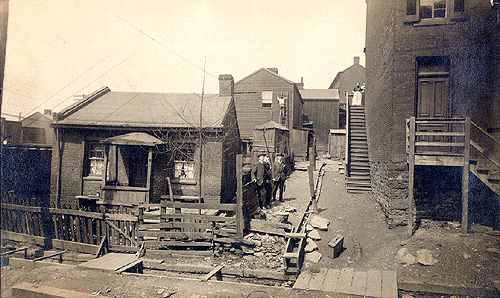
The privy-vault nuisance in this section is pernicious in the highest degree. Every house has its vault arranged usually in battery style and sending its sewage down the hillside. Back of Forbes Street in most cases the ground to the very houses and often even under the houses is thoroughly permeated with sewage foulness and dampness. 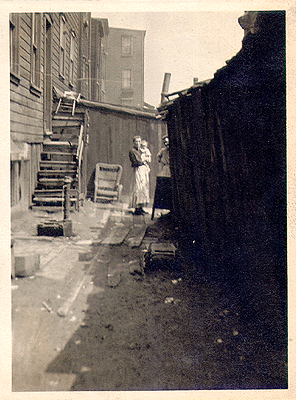 Wherever one turns the odor of the foul, unsanitary, privy-vault pervades the atmosphere. It is well to recall here the words of John Ihlder, Secretary of the National Housing Association: “No one who has given any thought to the subject is ignorant of the price in sickness and death which our cities pay for the privilege of permitting the continued existence of privies in thickly settled districts.”
Wherever one turns the odor of the foul, unsanitary, privy-vault pervades the atmosphere. It is well to recall here the words of John Ihlder, Secretary of the National Housing Association: “No one who has given any thought to the subject is ignorant of the price in sickness and death which our cities pay for the privilege of permitting the continued existence of privies in thickly settled districts.”
Let us now once again get a general view of our District–a black sheep, as it were, at the rear door of an admirable and very exclusive section of the city.
What an anomaly we have here! The Schenley Farms District with its wonderful semi-public buildings and magnificent rich men’s homes produced by Pittsburgh’s millions and these squalid hovels and dilapidated tenements for workingmen–they too a product of Pittsburgh’s millions or should I say perhaps Pittsburgh’s greed for millions?
In talking over the housing situation, a prominent business man said the other day: “But within the past six or seven years Pittsburgh has realized wonderful improvements.” It is indeed true. Every cloud has its silver lining and in this case it is the Schenley Farms District. But what benefits does it confer upon the inhabitants of our unsanitary houses and tenements, to whom the ominous, dark side of the cloud is horrible, lifelong reality?
Yet we must not get the impression that the situation is altogether dark. A reawakening due to the recognition of the bad housing conditions in Pittsburgh is already visible. The Chamber of Commerce and other civic organizations are doing conscientious work. The Chamber of Commerce Housing Committee has developed a plan for the building of small sanitary dwellings for workingmen which seems practical as well for the investor as for the prospective dweller.
May it not be that the district we have studied might prove the logical one for the inauguration of this committee’s plan? And perhaps then, too, prophecy may become fact and,
“Instead of the thorn shall come
up the fir tree, and instead of the briar
shall come up the myrtle tree.
And they shall build houses and inhabit
them; and they shall plant vineyards
and eat the fruit of them.”